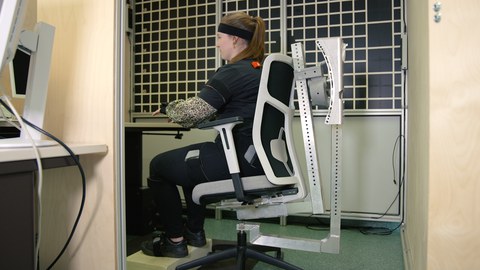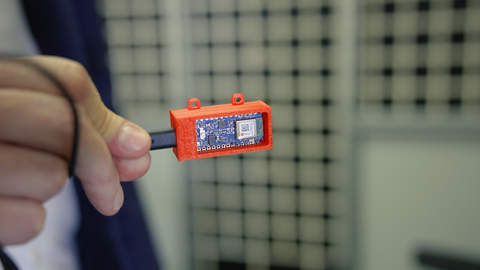04.10.2023
Forschende der TU Dresden entwickeln Sensor und Software zur Bewegungsförderung von Büroangestellten
Langes Sitzen macht krank und Bewegungsmangel kann zu physischen sowie psychischen Erkrankungen führen. Büroangestellte haben ein besonders hohes Risiko für Rückenschmerzen und chronische Muskel- und Skeletterkrankungen, da sie täglich viele Stunden sitzen. Wissenschaftler:innen der TU Dresden haben im Rahmen des Projekts Own Personal Care (OPC) Bürostühle hinsichtlich ihrer Mechanik untersucht und einen Sensor entwickelt, der in Kombination mit einer Anwendungssoftware in Zukunft dazu beitragen kann, dass sich Beschäftigte bei der Büroarbeit mehr und bewusster bewegen.
Um Krankheiten vorzubeugen, wird Personen, die viel sitzen, oft empfohlen, sich mehr zu bewegen. Dies kann durch Gehen, einem Wechsel zwischen verschiedenen Haltungen und Belastungen erreicht werden. Sogenannte dynamische und 3D-Bürostühle verfügen je nach Mechanik über einen unterschiedlichen Drehpunkt und erzeugen damit beim Sitzenden eine bestimmte Art der Hüftbewegung. Das Projekt Own Personal Care untersuchte, welche Mechanik die natürliche Bewegung der Hüfte und Wirbelsäule am besten nachbildet, wie viel Neigung der Sitzfläche förderlich ist und mit welcher Frequenz sich im Sitzen bewegt werden sollte.
„Wir haben bei einer Vielzahl von 3D-Bürostühlen die oben genannten Merkmale untersucht und konnten feststellen, dass Bürostühle mit einem Drehzentrum oberhalb der Sitzfläche (ähnlich einem Pendel oder Schaukelstuhl) aus biomechanischer Sicht am günstigsten sind. Von allen betrachteten Modellen entspricht die für den Benutzer entstehende Art der Bewegung am vergleichbarsten einer gehenden Bewegung für Becken und Wirbelsäule. Dadurch können die Bandscheiben mit Nährstoffen versorgt werden und die Rückenmuskulatur wird be- und entlastet“, erklärt Mark Bührer, Projektleiter von OPC. „Im weiteren Verlauf des Projektes haben wir aus den Ergebnissen einen Sensor entwickelt, der das Bewegungsverhalten im Sitzen aufzeichnet und gemeinsam mit einer Anwendungssoftware präventiv dazu eingesetzt werden kann, um mehr Bewegung in den Büroalltag zu bekommen“, ergänzt Bührer.
Der Sensor wird unter der Sitzfläche des Bürostuhls befestigt. Er zählt aufgrund verschiedener Parameter die Anzahl der Bewegungswechsel, berechnet den Energieverbrauch in Kilokalorien und gibt dem Benutzer eine virtuell zurückgelegte Wegstrecke aus. Diese ergibt sich aus der Kombination der Anzahl der Bewegungswechsel und einer durchschnittlichen Schrittlänge, die auf der Grundlage der im Sitzen ausgeführten Bewegungen ermittelt wird. Mit dem Sensor wird Beschäftigten und Führungskräften ein präventives Rahmenwerk zur Verfügung gestellt. Gekoppelt ist der Sensor mit einer Anwendungssoftware, welches der sitzenden Person hilft, die eigene Bewegung im Blick zu haben. Sensor und Software sind aktuell zum Patent eingereicht. Diese Innovation könnte zukünftig eine wichtige Aufgabe in der Präventionsarbeit übernehmen.
In einem neuen Video der TUD-Reihe »Kurze Frage« gibt Projektleiter Mark Bührer Einblicke in die Forschung des Projektes Own Personal Care und beantwortet die Frage, wie der optimale Bürostuhl aussieht:
© TU Dresden
Das Projekt OPC wird von der Karl-Schlecht Stiftung gefördert.
Kontakt:
Mark Bührer, M.Eng.
TU Dresden
Institut für Technische Logistik und Arbeitssysteme
Professur für Arbeitswissenschaft
Telefon: +49 351 463-38130
E-Mail:


